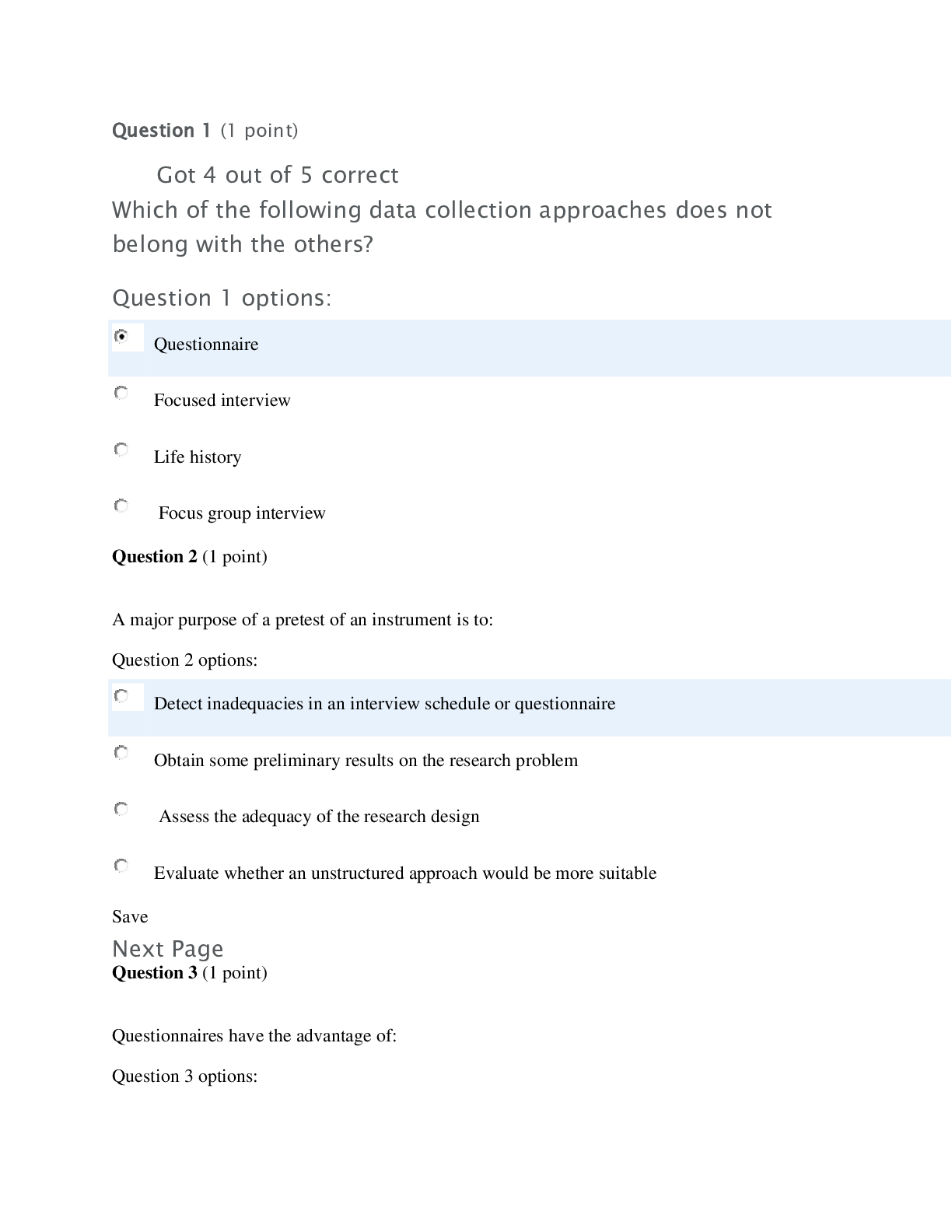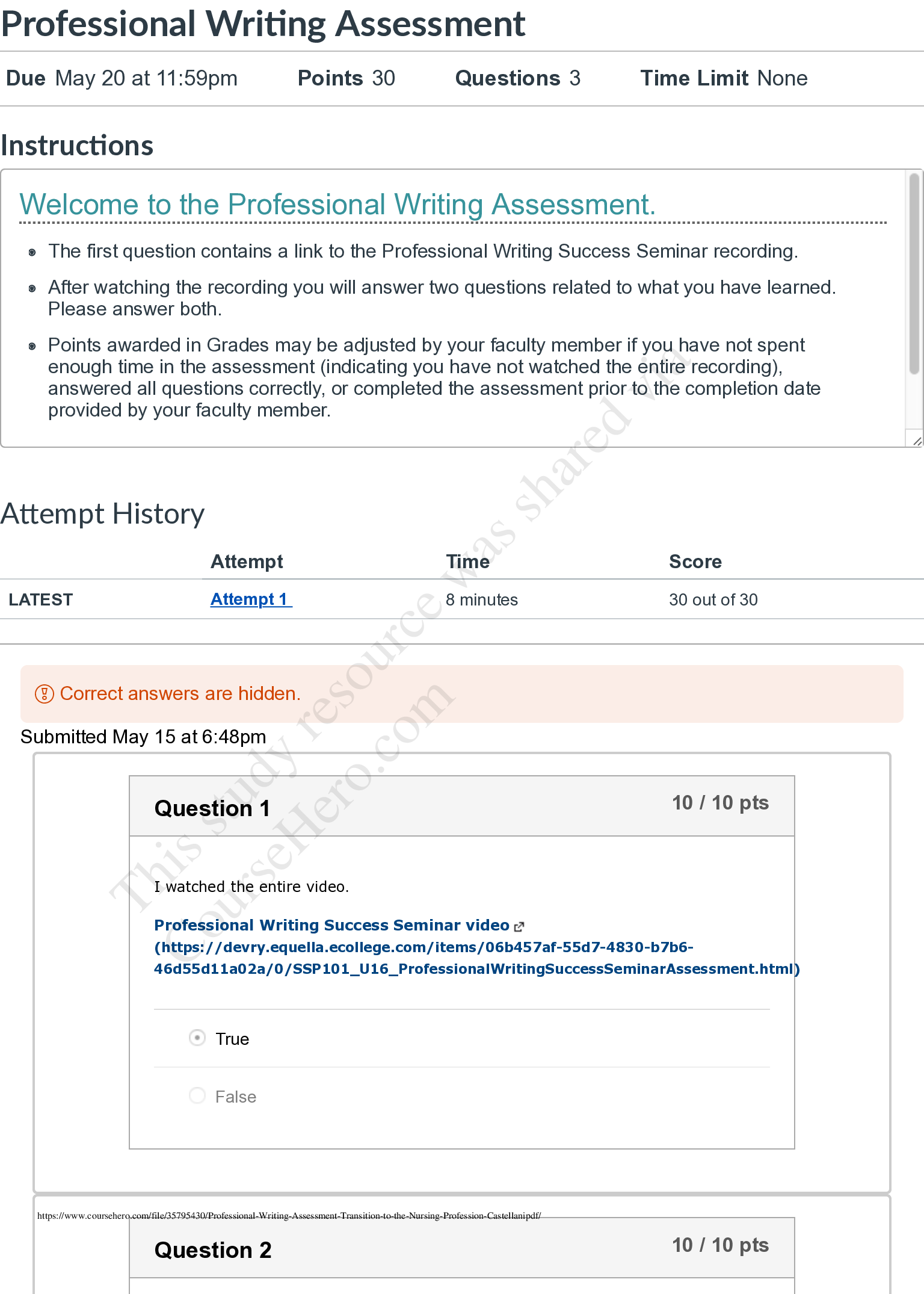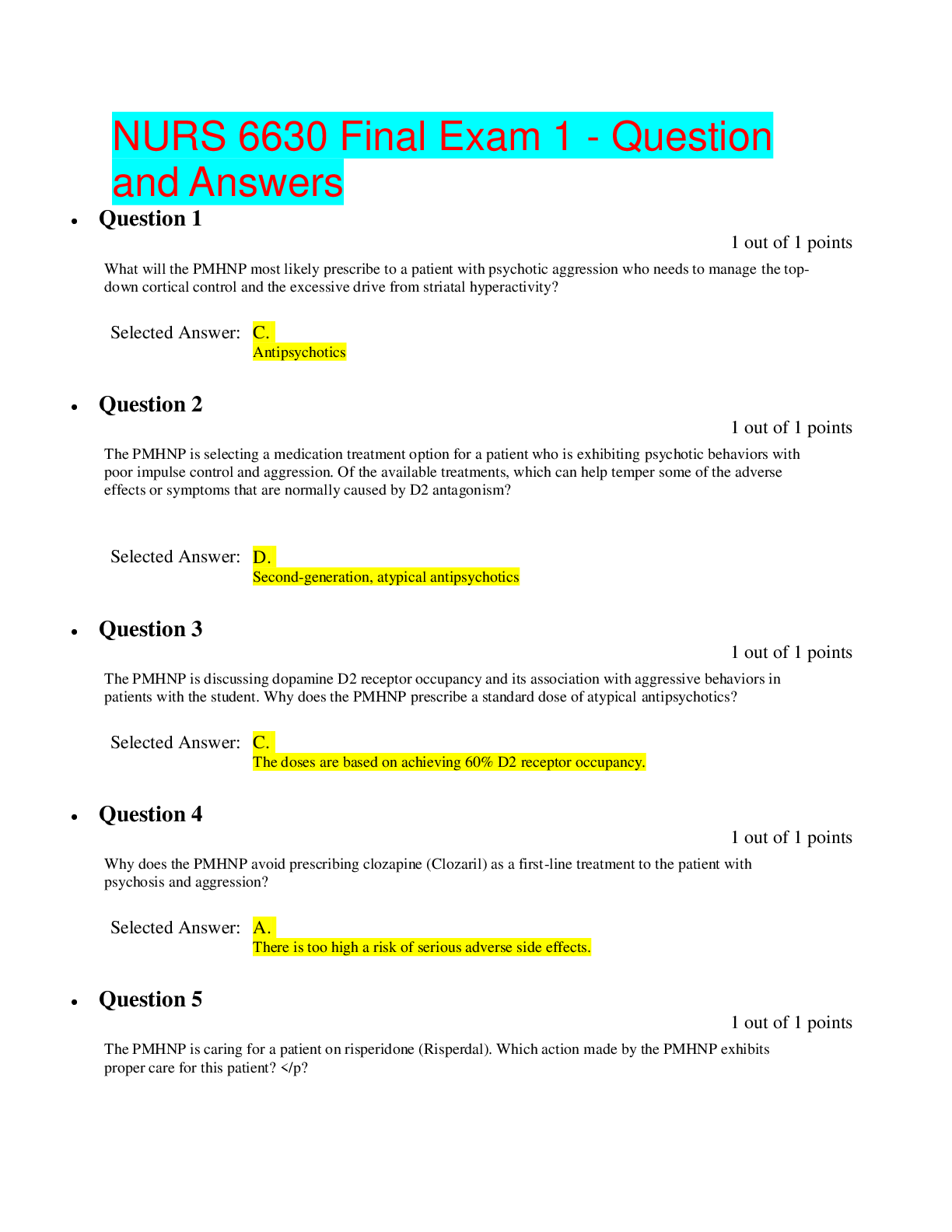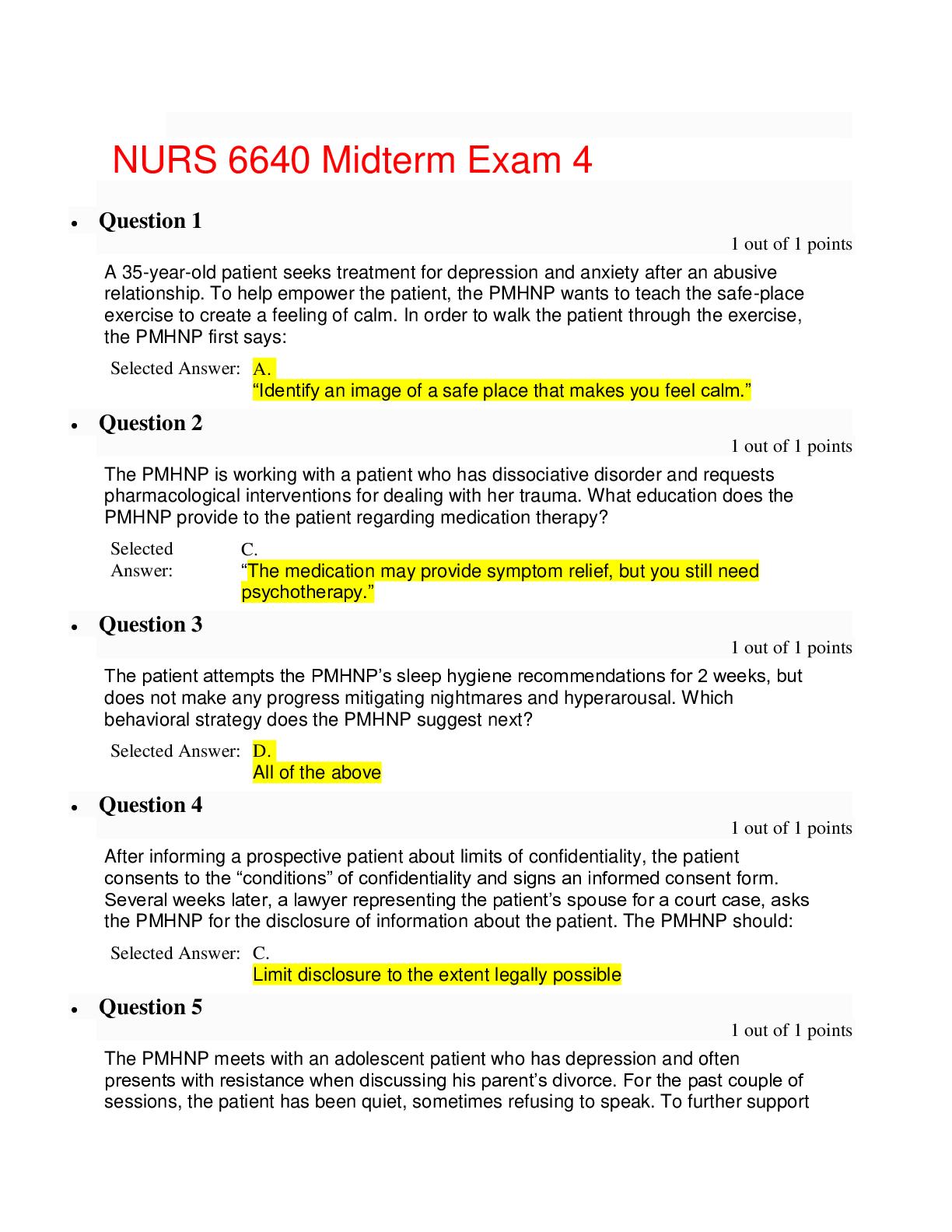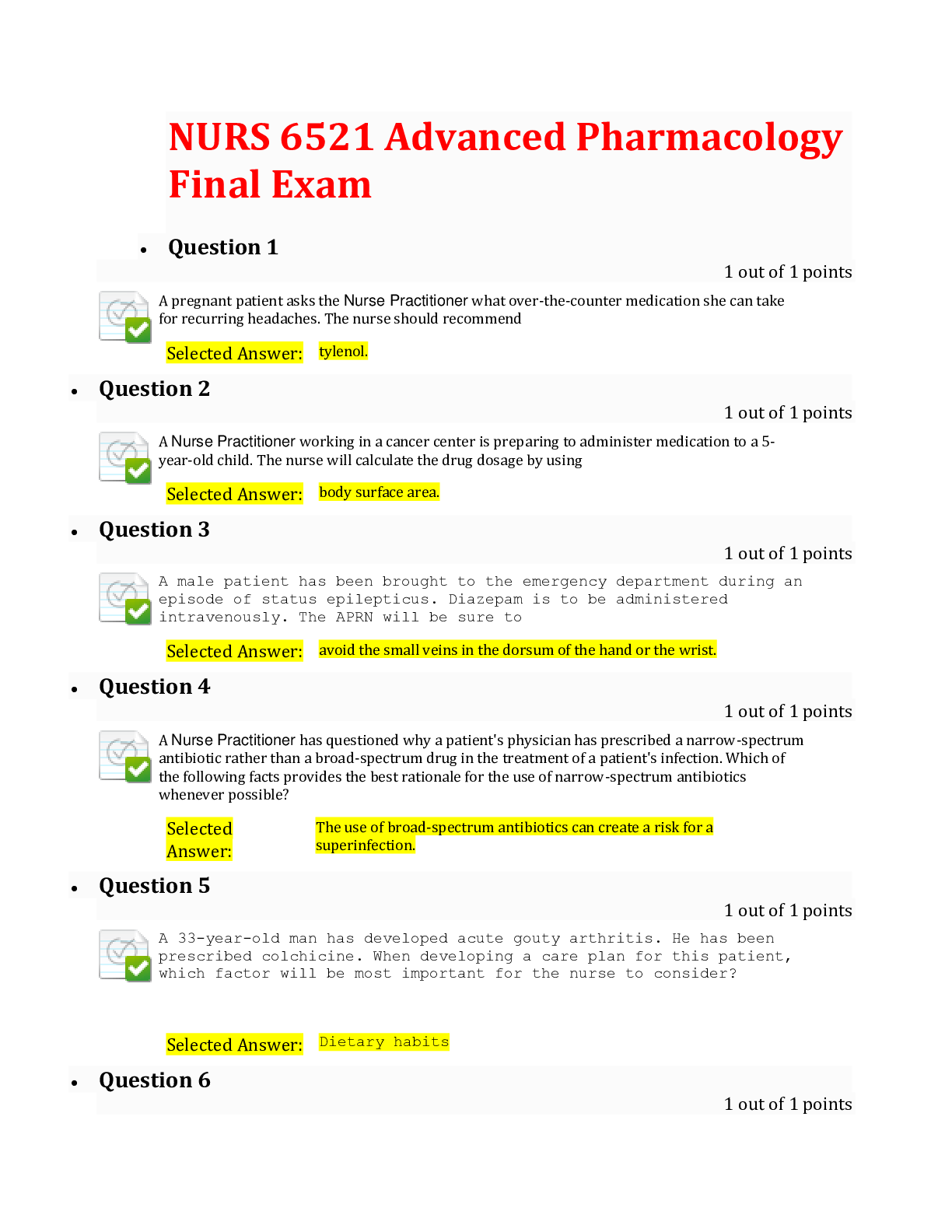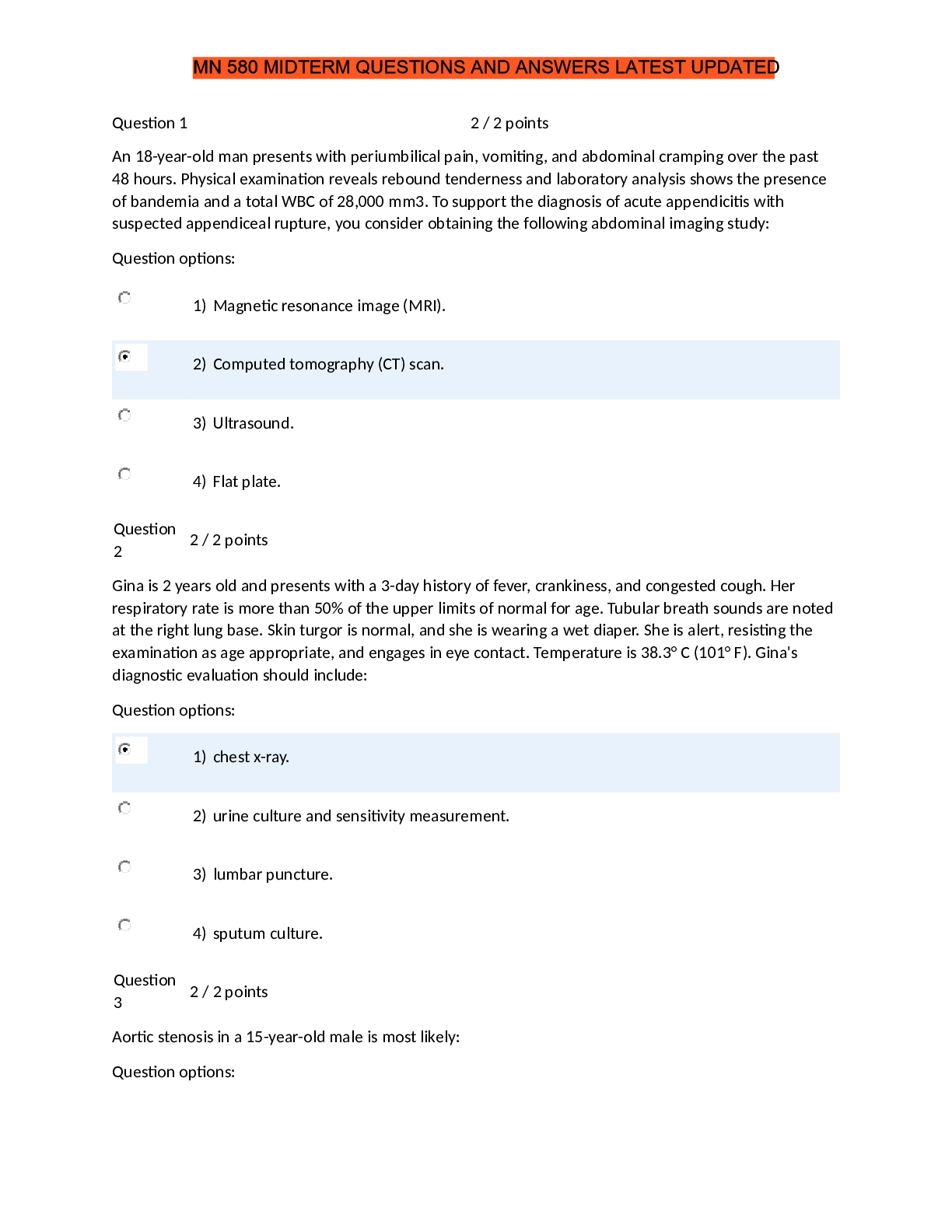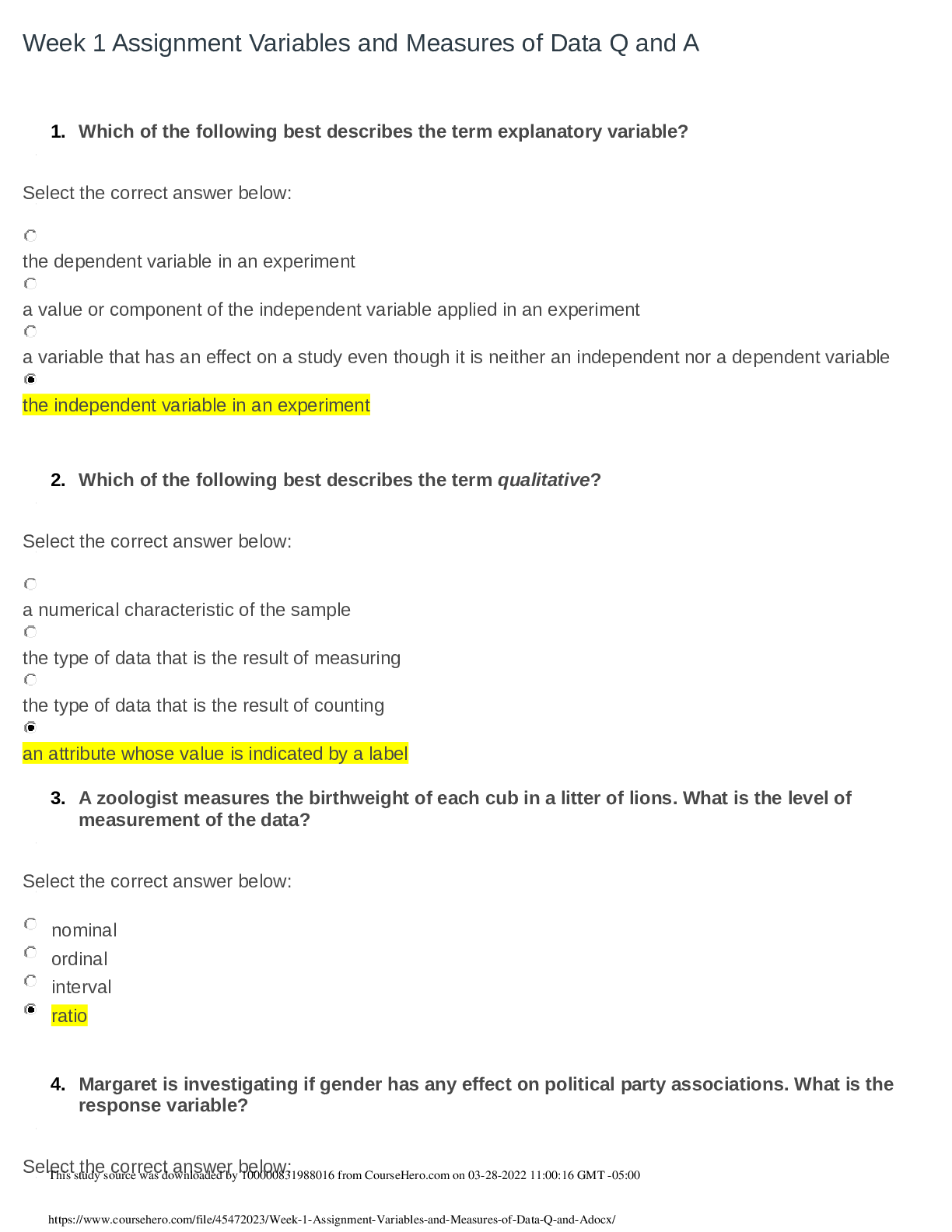*NURSING > EXAM > Nursing 201 OB/PEDS 3 Questions And Answers /Latest 100% Correct Grade A Upadated Version (All)
Nursing 201 OB/PEDS 3 Questions And Answers /Latest 100% Correct Grade A Upadated Version
Document Content and Description Below
Question 1 1 / 1 pts Which statement best describes the infant’s physical development? Binocularity is well established by age 8 months. Maternal iron stores persist during the fi... rst 12 months of life. Anterior fontanel closes by age 6 to 10 months. Correct! Birth weight doubles by age 5 months and triples by age 1 year. Growth is very rapid during the first year of life. The birth weight approximately doubles by age 5 to 6 months and triples by age 1 year. The anterior fontanel closes at age 12 to 18 months. Binocularity is not established until age 15 months. Maternal iron stores are usually depleted by age 6 months. Question 2 1 / 1 pts According to Piaget, school age is in which stage of cognitive development, or period of: Correct! Concrete operations. Formal operations. Postconventional thought. Conventional thought. Cognitive thinking for the school age concrete operational. This stage, the period of begining of abstract thinking, is Piaget’s third stage. The concrete operations stage usually develops between ages 7 and 11 years. Conventional and postconventional thought refer to Kohlberg’s stages of moral development. Question 3 1 / 1 pts Which statement is most descriptive of pediatric family-centered care? Correct! It recognizes that the family is the constant in a child’s life. It encourages family dependence on the health care system. It avoids expecting families to be part of the decision-making process. It reduces the effect of cultural diversity on the family. The key components of family-centered care are for the nurse to support, respect, encourage, and embrace the family’s strength by developing a partnership with the child’s parents. Family-centered care recognizes the family as the constant in the child’s life. The nurse should support the cultural diversity of the family, not reduce its effect. The family should be enabled and empowered to work with the health care system and to be part of the decision-making process. Question 4 1 / 1 pts The major cause of death for children older than 1 year is: Correct! Unintentional injuries. Congenital abnormalities. Cancer. Infection. Unintentional injuries (accidents) are the leading cause of death after age 1 year through adolescence. Congenital anomalies are the leading cause of death in those younger than 1 year and are less significant in this age group. There have been major declines in deaths attributed infection as a result of improved therapies. Cancer is the second leading cause of death in this age group. Question 5 1 / 1 pts Which drug is usually the best choice for patient-controlled analgesia (PCA) for a child in the immediate postoperative period? Correct! Morphine Meperidine Methadone Codeine The most commonly prescribed medications for PCA are morphine, hydromorphone, and fentanyl. Parenteral use of codeine is not recommended. Methadone is not available in parenteral form in the United States. Meperidine is not used for continuous and extended pain relief. Question 6 1 / 1 pts How does the onset of the pubertal growth spurt compare in girls and boys? It is about the same in both boys and girls. Correct! It occurs earlier in girls. It occurs earlier in boys. In both boys and girls it depends on their growth in infancy. Usually, the pubertal growth spurt begins earlier in girls. It typically occurs between the ages of 10 and 14 years for girls and 11 and 16 years for boys. The average earliest age at onset is 1 year earlier for girls. There does not appear to be a relation to growth during infancy. Question 7 1 / 1 pts The nurse is taking a health history on an adolescent. What best describes how the chief complaint should be determined? Interview the parent away from the adolescent to determine the chief complaint. Correct! Ask the adolescent, “Why did you come here today?” Ask for a detailed listing of symptoms. Use what the adolescent says to determine, in correct medical terminology, what the problem is. The chief complaint is the specific reason for the child’s visit to the clinic, office, or hospital. Because the adolescent is the focus of the history, this is an appropriate way to determine the chief complaint. A listing of symptoms will make it difficult to determine the chief complaint. The adolescent should be prompted to tell which symptom caused him or her to seek help at this time. The chief complaint is usually written in the words that the parent or adolescent uses to describe the reason for seeking help. The parent and adolescent may be interviewed separately, but the nurse should determine the reason the adolescent is seeking attention at this time. Question 8 1 / 1 pts The mother of a school-age child tells the school nurse that she and her spouse are going through a divorce. The child has not been doing well in school and sometimes has trouble sleeping. The nurse should recognize this as: Correct! Common reaction to divorce. Unusual response that indicates need for referral. Suggestive of lack of adequate parenting. Indicative of maladjustment. Parental divorce affects school-age children in many ways. In addition to difficulties in school, they often have profound sadness, depression, fear, insecurity, frequent crying, loss of appetite, and sleep disorders. Uncommon responses to parental divorce include indications of maladjustment, the suggestion of lack of adequate parenting, and the need for referral. Question 9 0 / 1 pts A nurse is assessing the growth and development of a 14-year-old boy. He reports that his 13-year-old sister is 2 inches (5 cm) taller than he is. The nurse should advise the growth spurt in adolescent boys, compared with the growth spurt of adolescent girls: You Answered Occurs 1 year later Occurs about 2 years earlier Correct Answer Occurs 2 years later Occurs at the same time Adolescent boys lag about 2 years behind adolescent girls. Most girls are 1-2 inches taller than boys at the beginning of adolescence Question 10 1 / 1 pts Which aspect of cognition develops during adolescence? Ability to see things from the point of view of another Ability to place things in a sensible and logical order Correct! Capability to use a future time perspective Progress from making judgments based on what they see to making judgments based on what they reason Adolescents are no longer restricted to the real and actual. They also are concerned with the possible; they think beyond the present. During concrete operations (between ages 7 and 11 years), children exhibit the ability to place things in a sensible and logical order, the ability to see things from another’s point of view, and the ability to make judgments based on what they reason rather than just what they see. Question 11 0 / 1 pts According to Erikson, the psychosocial task of a toddler is developing: You Answered Intimacy. Independence Correct Answer Autonomy Initiative. Traditional psychosocial theory holds that the developmental crises of a toddler lead to the formation of a sense of autonomy. Intimacy is the developmental stage for early adulthood. Initiative is the developmental stage for early childhood. Independence is not one of Erikson’s developmental stages. Question 12 1 / 1 pts Which factor is most important in predisposing toddlers to frequent infections such as otitis media, tonsillitis, and upper respiratory tract infections? Pulse and respiratory rates are slower than those in infancy. Respirations are abdominal. Correct! Short, straight internal ear/throat structures and large tonsil/adenoid lymph tissue are present. Defense mechanisms are less efficient than those during infancy. Toddlers continue to have the short, straight internal ear canal of infants. The lymphoid tissue of the tonsils and adenoids continues to be relatively large. These two anatomic conditions combine to predispose the toddler to frequent infections. The abdominal respirations and lowered pulse and respiratory rate of toddlers do not affect their susceptibility to infection. The defense mechanisms are more efficient compared with those of infancy. Question 13 1 / 1 pts The nurse is doing a routine assessment on a 14-month-old infant and notes that the anterior fontanel is closed. This should be interpreted as: A questionable finding—the infant should be rechecked in 1 month. Correct! A normal finding. An abnormal finding—indicates the need for immediate referral to a practitioner. An abnormal finding—indicates the need for developmental assessment. Because the anterior fontanel normally closes between ages 12 and 18 months, this is a normal finding, and no further intervention is required. Question 14 1 / 1 pts The nurse is having difficulty communicating with a hospitalized 6-year-old child. What technique may be most helpful? Correct! Ask the child to draw a picture. Ask the parent whether the child is always uncommunicative. Suggest that the parent read fairy tales to the child. Suggest that the child keep a diary. Drawing is one of the most valuable forms of communication. Children’s drawings tell a great deal about them because they are projections of the child’s inner self. It would be difficult for a 6-year-old child to keep a diary because the child is most likely learning to read. Reading fairy tales to the child is a passive activity involving the parent and child. It would not facilitate communication with the nurse. The child is in a stressful situation and is probably uncomfortable with strangers, not necessarily uncommunicative. Question 15 0 / 1 pts The near-to-far direction of growth is referred to as: Correct Answer Proximodistal. Sequential. You Answered Cephalocaudal. Mass to specific. The first pattern of development is the head-to-tail, or cephalocaudal, direction. The head end of the organism develops first and is large and complex, whereas the lower end is smaller and simpler, and development takes place at a later time. Proximodistal, or near-to-far, is the second pattern of development. Limb buds develop before fingers and toes. Postnatally the child has control of the shoulder before achieving mastery of the hands. Mass to specific is not a specific pattern of development. In all dimensions of growth, a definite, sequential pattern is followed. Question 16 1 / 1 pts The nurse is assessing a 6-month-old healthy infant who weighed 6 pounds at birth. The nurse should expect the infant to now weigh approximately: Correct! 12 pounds. 20 pounds. 10 pounds. 25 pounds. Birth weight doubles at about age 5 to 6 months. At 6 months, an infant who weighed 6 pounds at birth would weigh approximately 12 pounds. Ten pounds is too little; the infant would have gone from the 50th percentile at birth to below the 5th percentile. Twenty pounds or more is too much; the infant would have tripled the birth weight at 6 months. Question 17 1 / 1 pts A parent asks the nurse about how to respond to negativism in toddlers. The most appropriate recommendation is to: Punish the child. Provide more attention. Ask child not always to say “no.” Correct! Reduce the opportunities for a “no” answer. The nurse should suggest to the parent that questions should be phrased with realistic choices rather than “yes” or “no” answers. This provides a sense of control for the toddler and reduces the opportunity for negativism. Negativism is not an indication of stubbornness or insolence and should not be punished. The negativism is not a function of attention; the child is testing limits to gain an understanding of the world. The toddler is too young to be asked to not always say “no.” Question 18 1 / 1 pts The nurse is meeting a 5-year-old child for the first time and would like the child to cooperate during a dressing change. The nurse decides to do a simple magic trick using gauze. This should be interpreted as: Too distracting, when cooperation is important. Acceptable, if there is adequate time. Correct! A way to establish rapport. Inappropriate, because of child’s age. A magic trick or other simple game may help alleviate anxiety for a 5-year-old. It is an excellent method to build rapport and facilitate cooperation during a procedure. Magic tricks appeal to the natural curiosity of young children. The nurse should establish rapport with the child. Failure to do so may cause the procedure to take longer and be more traumatic. Question 19 1 / 1 pts When introducing hospital equipment to a preschooler who seems afraid, the nurse’s approach should be based on which principle? Explaining the equipment will only increase the child’s fear. One brief explanation is enough to reduce the child’s fear. Correct! The child may think the equipment is alive. The child is too young to understand what the equipment does. Young children attribute human characteristics to inanimate objects. They often fear that the objects may jump, bite, cut, or pinch all by themselves without human direction. Equipment should be kept out of sight until needed. The child should be given simple concrete explanations about what the equipment does and how it will feel to the child. Simple, concrete explanations help alleviate the child’s fear. The preschooler will need repeated explanations as reassurance. Question 20 1 / 1 pts The pediatric nurse understands that nonpharmacologic strategies for pain management: Usually take too long to implement. Make pharmacologic strategies unnecessary. Trick children into believing they do not have pain. Correct! May reduce pain perception. Nonpharmacologic techniques provide coping strategies that may help reduce pain perception, make the pain more tolerable, decrease anxiety, and enhance the effectiveness of analgesics. Nonpharmacologic techniques should be learned before the pain occurs. With severe pain it is best to use both pharmacologic and nonpharmacologic measures for pain control. The nonpharmacologic strategy should be matched with the child’s pain severity and taught to the child before the onset of the painful experience. Some of the techniques may facilitate the child’s experience with mild pain, but the child will still know that discomfort is present. Question 21 1 / 1 pts The nurse recommends to parents that peanuts are not a good snack food for toddlers. The nurse’s rationale for this action is that: Correct! They can be easily aspirated. They are very high in sodium. They are low in nutritive value. They cannot be entirely digested. Foreign-body aspiration is common during the second year of life. Although they chew well, children at this age may have difficulty with large pieces of food such as meat and whole hot dogs and with hard foods such as nuts or dried beans. Peanuts have many beneficial nutrients but should be avoided because of the risk of aspiration in this age-group. The sodium level may be a concern, but the risk of aspiration is more important. Many foods pass through the gastrointestinal tract incompletely digested. This is not necessarily detrimental to the child. Question 22 1 / 1 pts The nurse observes some children in the playroom. Which play situation exhibits the characteristics of parallel play? Danielle playing with a music box on her mother’s lap Adam playing a board game with Kyle, Steven, and Erich Kimberly and Amanda sharing clay to each make things Correct! Brian playing with his truck next to Kristina playing with her truck An example of parallel play is when both children are engaged in similar activities in proximity to each other; however, they are each engaged in their own play, such as Brian and Kristina playing with their own trucks side by side. Sharing clay is characteristic of associative play. A group of children playing a board game is characteristic of cooperative play. Playing alone on the mother’s lap is an example of solitary play. Question 23 1 / 1 pts An appropriate play activity for a 7-month-old infant to encourage visual stimulation is: Correct! Playing peek-a-boo. Imitating animal sounds. Playing pat-a-cake. Showing how to clap hands. Because object permanence is a new achievement, peek-a-boo is an excellent activity to practice this new skill for visual stimulation. Playing pat-a-cake and showing how to clap hands will help with kinesthetic stimulation. Imitating animal sounds will help with auditory stimulation. Question 24 1 / 1 pts A lumbar puncture is needed on a school-age child. The most appropriate action to provide analgesia during this procedure is to apply: A transdermal fentanyl (Duragesic) patch immediately before the procedure. 4% Liposomal Lidocaine (LMX) 15 minutes before the procedure. Correct! Eutectic mixture of local anesthetics (EMLA) 1 hour before the procedure. EMLA 30 minutes before the procedure. EMLA is an effective analgesic agent when applied to the skin 60 minutes before a procedure. It eliminates or reduces the pain from most procedures involving skin puncture. LMX must be applied 30 minutes before the procedure. Transdermal fentanyl patches are useful for continuous pain control, not rapid pain control. For maximal effectiveness, EMLA must be applied approximately 60 minutes in advance. Question 25 1 / 1 pts A father tells the nurse that his daughter wants the same plate and cup used at every meal, even if they go to a restaurant. The nurse should explain that this is: Regression, common at this age. Correct! Ritualism, common at this age. A way to exert unhealthy control. A sign that the child is spoiled. The child is exhibiting the ritualism that is characteristic at this age. Ritualism is the need to maintain sameness and reliability. It provides a sense of comfort to the toddler. It will dictate certain principles in feeding practices, including rejecting a favorite food because it is served in a different container. This does not indicate a child who has unreasonable expectations or a need to exert control, but rather normal development. Toddlers use ritualistic behaviors to maintain necessary structure in their lives. This is not regression, which is a retreat from a present pattern of functioning. Question 26 0 / 1 pts During a routine health assessment, the nurse notes that an 8-month-old infant has significant head lag. Which is the nurse’s most appropriate action? You Answered Teach the parents appropriate exercises. Refer the child for further evaluation if the anterior fontanel is still open. Recheck head control at the next visit. Correct Answer Refer the child for further evaluation. Significant head lag after age 6 months strongly indicates cerebral injury and is referred for further evaluation. Reduction of head lag is part of normal development. Exercises will not be effective. The lack of achievement of this developmental milestone must be evaluated. Question 27 0 / 1 pts An infant who weighs 7 pounds 6 ounces at birth would be expected to weigh how many pounds at age 1 year? Correct Answer 22.8 You Answered 21 14 16 In general birth, weight triples by the end of the first year of life. For an infant who was 7 pounds 6ounces at birth, 22.8 pounds would be the anticipated weight at the first birthday. Weights of 14, 16, and 21 pounds are less what would be expected for an infant with a birth weight of 7 pounds 6 ounces Question 28 1 / 1 pts The type of injury a child is especially susceptible to at a specific age is most closely related to: Physical health of the child. Correct! Developmental level of the child. Educational level of the child. Number of responsible adults in the home. The child’s developmental stage determines the type of injury that is likely to occur. The child’s physical health may facilitate his or her recovery from an injury. Educational level is related to developmental level, but it is not as important as the child’s developmental level in determining the type of injury. The number of responsible adults in the home may affect the number of unintentional injuries, but the type of injury is related to the child’s developmental stage. Question 29 1 / 1 pts While assessing the development of a 9-month-old client, the nurse asks the mother if the child actively looks for toys that are placed out of site. Which is the nurse assessing with this question to the parent? Conservation Transductive reasoning Centration Correct! Object permanence Object permanence has developed by 9-months Question 30 1 / 1 pts The nurse assesses the vital signs of a 12-month-old infant with a respiratory infection and notes that the respiratory rate is 35 breaths/minute. On the basis of this finding which action is most appropriate? Notify the health care provider Administer oxygen Correct! Document the findings Reassess the respiratory rate in 15 minutes Normal respiratory rate in a 12-month infant is 20-40 breaths/minute. The nurse would document the findings. Question 31 1 / 1 pts The maternity nurse is providing instructions to a new mother regarding psychosocial development of the newborn infant. Using Erikson psychcosocial development theory, the nurse instructs the mother to take which measure? Anticipate all neds of the newborn infant. Correct! Allow the newborn infant to signal a need. Avoid the newborn infant during the first 10 minutes of crying Attend to the newborn infant immediately when crying According to Erikson the caregiver should try not to anticipate the newborn nfant needs at all times allow the infant to signal needs. If the newborn is not allow to signal needs they will not learn how to control the enviroment. Delayed or prolonged response to newborn infant`s signal would inhibit the development of trust and lead to mistrust Question 32 1 / 1 pts Which finding would the nurse consider abnormal when performing a physical assessment of a 6-month-old? Anterior fontanel is open Able to track and follows objects Beginning signs of tooth eruption Correct! Posterior fontanel is open. The posterior fontanel should close between 6-8 weeks of age Anterior closes between 14-18 months The infant hsa a first tooth erupted at about 6 months The infant should be able to track objects at 6 months Question 33 1 / 1 pts A 4-year-old hospitalized with FTT has an order for daily weights, strict intake and output, and calorie counts. Which action by the nurse would be a concern? The nurse sits with the child while the child eats her breakfast. The nurse weighs the child with no clothing except undergarments. Correct! The nurse weighs the child every morning after breakfast. The nurse weighs the child using the same scale every orning. The should be weighed every day on the same scale before eating. Weigh will not be accurate after eating.Weigh only in udergarments. Remain with the child when eating in order to record accurately what the child and drank. Use same scale to obtain an accurate weight Question 34 1 / 1 pts A nursing is administrating vancomycin intravenously and sets the pump to infuse the medication over 90 minutes. Which adverse reaction is the nurse trying to prevent? Correct! Flushing of the face, neck, and chest Vomiting Hypertension Headache Vomiting is a side effect but not related to infusing rate. Headache is not related to infusion rate Red man syndrome is flushing or red neck syndrome is flushing of the face,neck, and upper chest associated with to rapid of an infusion of vancomycin rate should be 90-120 minutes. Can pretreat with benadryl prior to infusion Question 35 0 / 1 pts Which would the nurse include when teaching an adolescent female beginning isotretinoin (Accutane) therapy? You Answered Apply a thin layer to the affected skin twice a day. Correct Answer A pregnancy test will be done prior to starting therapy. Keep lips moistened toprevent inflammation Use Dove Sensitive Skin soap for added benefit. The drug is topical Dove Sensitive Soap is used for dry or easily irritated skin It is manadatory to have a pregnancy test done before starting treatment because spontaneous abortions and/or fetal abnormalities have been associated in pregnancy with the use of Accurane Inflammation of the lips is a side effect of Accurane, but lip moisture will not prevent it Question 36 1 / 1 pts Which assessment should be a priority to monitor in a child receiving a narcotic pain relief? Bowel sounds oxygen saturation Correct! Respirations Blood pressure Adverse effect of narcotics that put the greatest risk is respirarory depression and decreased LOC Bowel sounds should be assessed because opioids can decrease gastric motility Blood pressure could decrease and should be assessed but is not the priority Oxygen saturation will decrease after a decrease in respiratory effort Question 37 1 / 1 pts Which should the nurse teach the parents is one of the most common causes of injury and death for a 9-month-old infant? Dog bites Child abuse Poisonng Correct! Aspiration Poisoning is more common among toddlers Abuse is not a leading cause of death Aspiration is a more common cause of death and injury among children this age Dog bites are not a leading cause of injury or death among children Question 38 1 / 1 pts A 9-year-old girl builds a clubhouse in her backgroud. She hangs a sign outside her clubhouse that has “No boys allowed” printed on it. The child`s parents are concerned tha she is excluding their neighbor`s son and they are upset. What should the nurse tell the child`s parents? Correct! Her behavior is common among school-age children. Her feeling about boys will subside within the next year Her behavior is cause for concern and should be addressed. They should have the child speak with a school counselor The child`s behavior is normal. Girls 9 and 10 generally perfer friends of the same gender.There is no need to see a counselor Question 39 1 / 1 pts An adolescent has a diagnosis of new-onset diabetes. What would most influence a teenager`s food choices as he begins to make changes in his diet? Television and other forms pf media influences Cultural background. Parent`s and dietary choices. Correct! Peers and their dietary choices. Family does have influence on teen`s choices however teens are more focused on being like their peers. Culture does not influence food choices, however tens are more likely to choose junk foods. As a teen the child is most influence by their peers. Television ahs little influence on teen`s food choices. Question 40 0 / 1 pts A charge nurse is making assignments for a group of children on a pediatric unit. The charge nurse should avoid asssigning the same nurse to care for a 2-year-old with respiratory syncytial virus (RSV) and: a 6-month-old with sickle cell crisis. an 18-month-old with RSV. Correct Answer a 1-year-old with a heart defect. You Answered a 9-year-old 3 days post appendectomy. RSV may be spread both through direct and indirectontract. While contact isolation is standard precautions are employed to decrease nosocomial infection so avoid assigning a nurse to a patient who is at risk for infection. Older children are less likely to contact RSV. Children with conditions are more likely to contract the infection Question 41 1 / 1 pts Which medications are the most effective choices for treating pain associated with inflammation in children (Select all that apply)? Correct! Ibuprofen (Advil) Correct! naporxen (Aleve) Morphine Correct! Ketorolac (Toradol) Acetaminophen (Tylenol) Ibuprofen, naproxen/naproxen sodium, and ketorolac are all types of NSAIDs, which are used primarily for pain associated with inflammation. Opioids, such as morphine, are the preferred drugs for the management of acute, severe pain, including postoperative pain, post-traumatic pain, pain from vaso-occlusive crisis, and chronic cancer pain. Acetaminophen lacks the antiinflammatory effects of NSAIDs and provides only minimal antiinflammatory relief. Question 42 0.5 / 1 pts Which are characteristic of the physical development of a 30-month-old child (select all that apply)? Correct! Primary dentition is complete. Length from birth is doubled. Correct! Sphincter control is achieved. Correct Answer Birth weight has quardupled Correct Answer Anterior fontanel is closed Question 43 0.75 / 1 pts Which development is necessary for toilet training readiness for a 2-year? Select all that apply Correct! Adequate neuromuscular development for sphincter control Correct Answer Toddlers are curious about what goes on in the bathroom Stay dry for 4 hours Correct! Desire to please parents Correct! Ability to communicate the need to use the toilet Question 44 1 / 1 pts Which data would be included in a health history (Select all that apply)? Correct! Nutritional assessment Physical assessment Correct! Family medical history Growth measurements Correct! Sexual history Correct! Review of systems The review of systems, sexual history, nutritional assessment, and family medical history are part of the health history. Physical assessment and growth measurements are components of the physical examination. Question 45 0 / 1 pts A parent of a 3-year-old child tells a clinic nurse that the child is rebelling constantly and having temper tantrums. Using Erikson`s psychosocial development theory, which instruction should the nurse provide to the to the parent? You Answered Ignore the child when this behavior occurs Correct! Provide a simple explanation of why the behavior is unacceptable Punish the child every time the child says “no” to change the behavior Correct Answer Set limits on the child`s behavior You Answered Allow this behavior, because it is normal at this age Parents should set limits manitain routines to prevent acting out.Parents should remain calm. Tantrums are a way a child expresses themselves. As language skills improve tantrums decrease [Show More]
Last updated: 1 year ago
Preview 1 out of 18 pages
Instant download
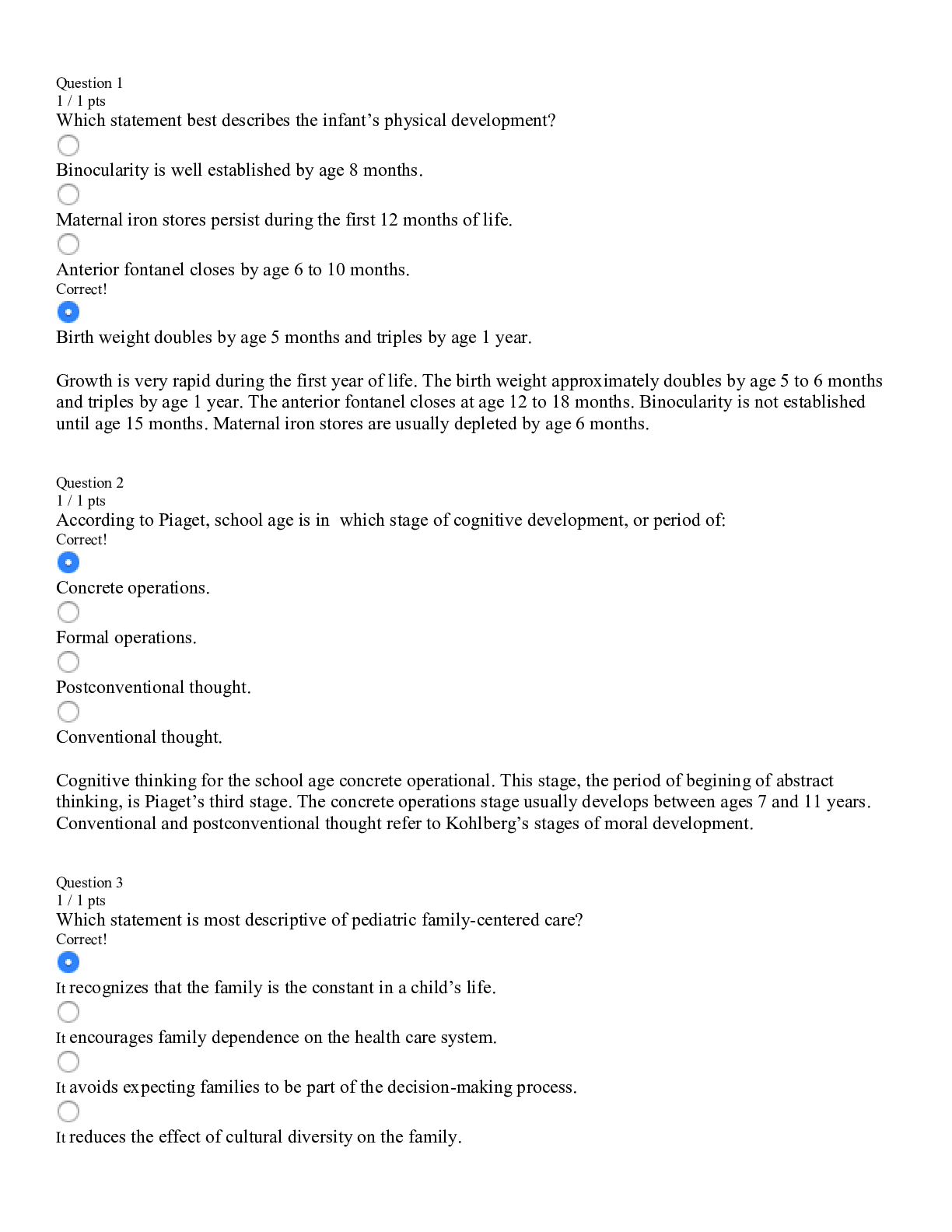
Buy this document to get the full access instantly
Instant Download Access after purchase
Add to cartInstant download
Reviews( 0 )
Document information
Connected school, study & course
About the document
Uploaded On
Sep 18, 2020
Number of pages
18
Written in
Additional information
This document has been written for:
Uploaded
Sep 18, 2020
Downloads
0
Views
41





.png)


